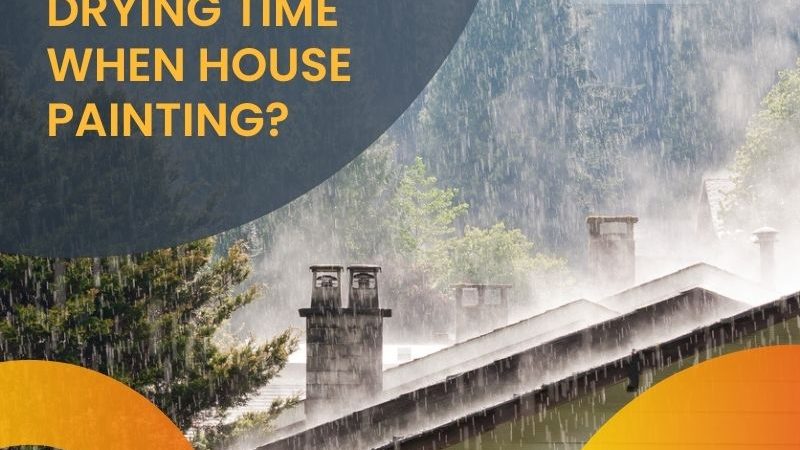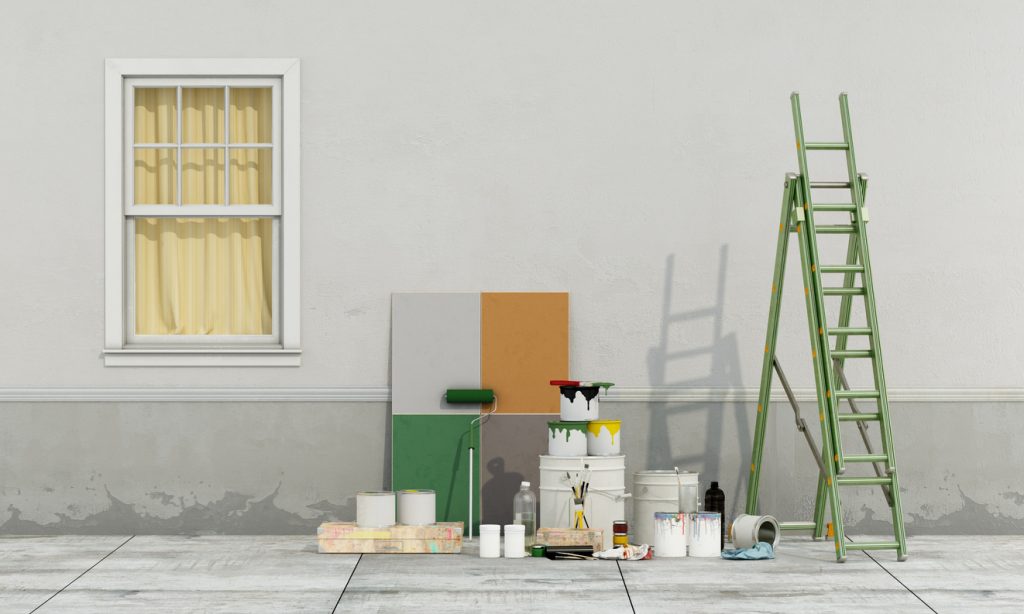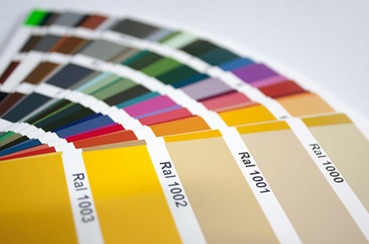
Rain is one of the major biggest obstacles to exterior painting. If it’s raining outside, you cannot paint. Instead, you must put off your project first and wait until it stops raining.
Even if it stops raining, you cannot go out to paint right away while the surface is still damp. Not only will it affect the paint’s ability to dry and cure, but it can also lead to various surface problems. First, make sure the exterior surfaces are completely dry inside out before you start painting.
Ways that rain affects your exterior painting job
Here are some key reasons why rain is a challenge in exterior painting:
- Moisture – Rain introduces moisture to the surfaces intended for painting, such as walls, trim, and other exterior features. Paint requires a dry surface to adhere properly. Moisture can prevent paint from adhering effectively, leading to issues like peeling, blistering, or flaking once the paint dries.
- Drying time – Rain can significantly increase the drying time of paint. The paint must dry gradually at a controlled rate for optimal adhesion and durability. When rain interferes, it can cause the paint to dry unevenly or not at all, compromising the paint job’s quality and longevity.
- Water-based paints – While water-based paints are popular for their ease of use and environmental benefits, they are particularly susceptible to rain. Rain can dilute the paint while it’s still wet, affecting the color, texture, and uniformity of the coat.
- Temperature and humidity – Rain often brings cooler temperatures and higher humidity, adversely affecting paint application. The paint reacts differently under various temperature and humidity conditions, and these weather factors can hinder the chemical processes needed for the paint to cure properly.
- Scheduling delays – The unpredictability of rain can cause significant delays in painting projects. You must put off work before rain begins and cannot resume until surfaces are completely dry, leading to prolonged project times and potential inconvenience.
- Surface damage – Beyond the immediate impact on painting, rain can also expose or exacerbate issues in the painting surface, such as cracks, mold, or rot. These issues add complexity and potential delays to the project. Nevertheless, you should address these problems before proceeding to paint.
Due to these challenges, it’s crucial for painting projects to be planned with close attention to weather forecasts and for painters to use appropriate techniques and materials for the conditions. Preparing surfaces thoroughly, choosing the right type of paint, and applying it under favorable weather conditions can help mitigate the challenges posed by rain.
Can you still paint on a rainy day?
Weather forecasts may not be 100% accurate, but they allow you to anticipate the possibility of a rainy day and tell you whether you will be able to go outside to paint or make the proper preparations that will allow you to paint even on a rainy day, especially if the project is urgent.
If it rains tomorrow, it is best to put off your exterior painting project until it stops raining, the weather is fine again, and the surface is completely dried.
If painting is necessary and there’s a chance of light rain, using protective coverings or choosing a part of the structure that’s shielded from direct rain might be possible, but these are generally less ideal solutions. You should reschedule other exterior projects like deck restoration work to the next clear set of dates.
Since rain can affect your exterior painting job, you might as well want to consider some crucial points that will help you determine the right circumstances to paint outside:
- Most paints for exterior painting dry in a few hours as long as the user follows the manufacturer’s instructions. But not all paints are created equal since water-based paints (such as latex and acrylic) dry at a duration that differs from oil-based paints. Professional contractors evaluate the paints they or their clients have chosen and see how fast or slowly they dry.
- Professional and some DIY painters use the “sidewalk test,” which determines that if the sidewalk is completely dried, it generally means that the exterior walls and the siding are dried too and thus ready to receive paint.
- Weather conditions can significantly impact your exterior painting job, especially regarding the time it takes the exterior paint to dry. It’s okay to do the interior painting job even during an extended period of rain, as interior walls won’t be as affected by the precipitation. But if the exterior surfaces have been exposed to heavy rain, it is better to let the walls and the siding dry completely before you start painting.
How soon can you paint after the rain?
The answer depends on how damp the surface is. Painting outside after the rain requires waiting until the surfaces are completely dry. The specific time can vary depending on several factors, including the type of surface being painted, humidity levels, temperature, and ventilation.
Generally, it’s recommended to wait at least 24 to 48 hours after rain before painting exterior surfaces. This waiting period allows the surfaces to completely dry and ensures that the paint adheres properly and dries evenly, preventing issues like peeling or blistering.
Here are a few tips to consider:
- Check the surface — Some materials, like wood, may absorb more moisture and take longer to dry than others. Touch the surface to ensure it feels dry to the touch.
- Consider humidity and temperature – High humidity can prolong the drying time of surfaces and paint. Ideal painting conditions are typically when the humidity is between 40% and 70% and temperatures are between 50°F and 85°F (10°C to 29°C).
- Inspect the weather forecast – Look ahead to ensure no imminent rain showers could affect the newly applied paint. Also, give the paint enough time to cure before any potential rain, based on the manufacturer’s recommendations.
- Use moisture meters – For precision, especially with wood, use a moisture meter to ensure the moisture content is within the acceptable range for painting.
Always refer to the paint manufacturer’s instructions for specific recommendations regarding drying times and conditions for painting.
Make sure that the paints you choose are suitable for the type of surface you’ll be painting. Here’s an example: if your wood siding is now dry to the touch, it’s okay to use acrylic paints because the remaining moisture evaporates through the coating. What’s important is that the surface you plan to paint is completely dry and ready to receive paint.
Again, some materials may take longer to dry than others so you must always check the surface first. However, you can start or resume painting the next day if it’s nice out.
Conclusion
While it is impossible to counter the forces of nature, at least we can learn how to deal with them. There’s no need to worry about delayed exterior house painting. With the experience of professional painters, such as Custom Painting, Inc., you can be confident that the paint job will turn out exactly the way you’ve wanted. To learn about our interior and exterior residential paint services, call Custom Painting at 925-294-8062 or fill out the online form to request a free estimate.


